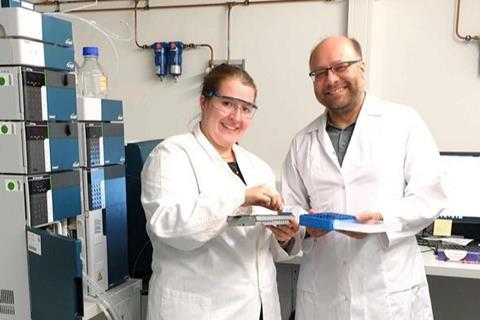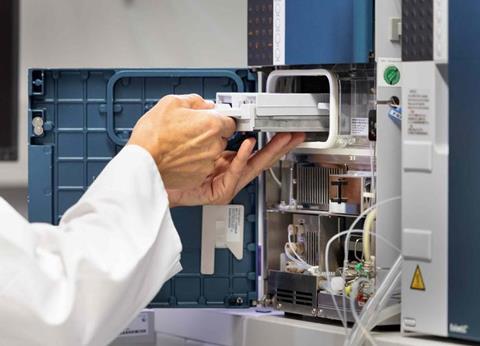Peptides formed during cheese ripening are crucial for the full-bodied flavor of aged cheeses, known as kokumi. A research team led by the Leibniz-Institute for Food Systems Biology at the Technical University of Munich has now developed a new method to analyze these flavor-relevant peptides precisely, quickly, and efficiently. Based on more than 120 cheese samples, the team has also created a database that can be used in the future to predict flavor development during cheese ripening.

The term kokumi derives from Japanese and refers to a full-bodied and long-lasting taste experience. The taste impression is particularly pronounced in aged cheeses, mainly due to the increasing concentration of gamma-glutamyl dipeptides. These are small molecules that consist of a link between glutamic acid and another amino acid.
READ MORE: Scientists break the mould by creating new colours of ‘blue cheese’
READ MORE: Research group identifies novel probiotics in traditional Brazilian cheeses
Depending on how the two amino acids are linked, researchers distinguish between gamma-, alpha-, and X-glutamyl dipeptides, with the latter two not contributing to the kokumi effect. The high polarity of the glutamyl dipeptides, as well as their great structural similarity with different flavor contributions, represent a major challenge for food analysis.
Efficient analysis method developed
Nevertheless, the team led by principal investigator Andreas Dunkel of the Leibniz Institute has succeeded in developing a new efficient analysis method based on ultra-high performance liquid chromatography-mass spectrometry. For the first time, it can precisely and selectively determine the concentrations of all 56 gamma-glutamyl dipeptide variants in just 22 minutes. Optimized sample preparation makes it possible to analyze 60 cheese samples per day.

“This is a significant improvement compared to other methods. Our tests have shown that our method is faster, more efficient, and yet reliable – it delivers reproducible results and detects even the smallest concentrations,” says first author Sonja Maria Fröhlich, a doctoral student at the Leibniz Institute. To further investigate the influence of ripening time on gamma-glutamyl dipeptide concentrations, the researchers applied the method to 122 cheese samples from Europe and the USA after the test phase. The ripening times of the cheese ranged from two weeks to 15 years.
Mold cultures accelerate flavor development
The results show that, as expected, the concentrations of glutamyl dipeptides increase with increasing ripeness. “Interestingly, the addition of blue and white mold cultures led to significantly higher gamma-glutamyl dipeptide concentrations, even at shorter ripening times,” says Andreas Dunkel, who heads the Integrative Food Systems Analysisresearch group at the Leibniz Institute.
The food chemist adds: “The concentration profiles we have determined for different stages of ripening and different types of cheese can be used in the future as a database for prediction models. The latter could, for example, be used to objectively monitor flavor development during cheese ripening, to shorten ripening times, or to develop new plant-based cheese products with high consumer acceptance.”
“In the sense of an interdisciplinary, food systems biology research approach, one of our goals is to combine analytical research results with bioinformatic methods to develop predictive models suitable to support sustainable food production. This is also the starting point of the project led by Andreas Dunkel,” concludes Veronika Somoza, director of the Leibniz Institute.
Peptides formed during cheese ripening are crucial for the full-bodied flavor of aged cheeses, known as kokumi. Researchers have now developed a new method to analyze these flavor-relevant peptides precisely, quickly, and efficiently.
Cheese factfile
Cheese is an integral part of the Western diet, with more than 1,000 types currently available. Further studies show that 54 percent of consumers prefer aged cheese to products with a shorter aging period. Only 16 percent prefer shorter-aged varieties.
According to Statista, Gouda, Edam and quark are among Germany’s most produced types of cheese. In 2022, the total consumption of Germans was around two million tons, corresponding to a per capita consumption of around 24 kilograms of cheese per year.
Kokumi does not refer to a distinct taste quality such as sweet, sour, bitter, salty, or umami but rather denotes a full-bodied, lasting, rounded, and balanced taste. Etymologists, who study the origin and development of words, ascribe three different meanings to the word kokumi: 1. heavy, dark (as in colors, e.g., dark blue), 2. thick (as in thickened liquids, e.g., sauces), 3. strong (as in espresso).







No comments yet